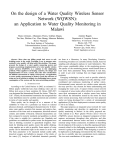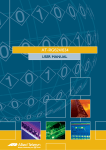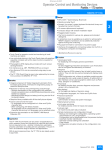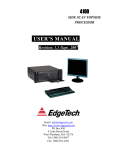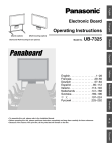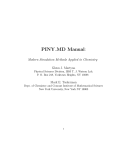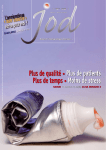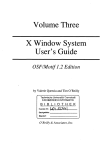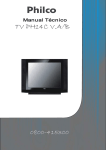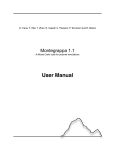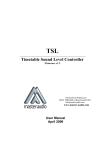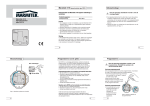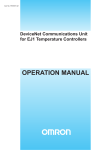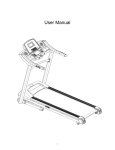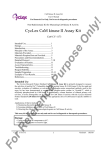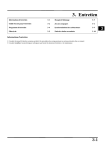Download PDF manual - FoldX plugin for YASARA
Transcript
Version 1.4.21 User manual 2 Table of contents Preface ................................................................................................................................ 3 Installation and first use...................................................................................................... 4 Installation....................................................................................................................... 4 First use........................................................................................................................... 5 Citing the plugin ................................................................................................................. 6 FoldX tools in YASARA.................................................................................................... 7 Preface............................................................................................................................. 7 Context menus ................................................................................................................ 8 FoldX energies ................................................................................................................ 9 Calculation speed ............................................................................................................ 9 Protein, DNA, nucleotides and metals recognized by FoldX ....................................... 10 Fix residues ................................................................................................................... 12 Free residues ................................................................................................................. 13 Repair object ................................................................................................................. 13 Stability of object.......................................................................................................... 14 Alanine scan of object................................................................................................... 15 Energy analysis of object .............................................................................................. 15 Interaction energy of molecules.................................................................................... 16 Mutate residue............................................................................................................... 17 Mutate multiple residues............................................................................................... 22 Build homology model ................................................................................................. 25 Save last calculation...................................................................................................... 26 Configure plugin ........................................................................................................... 26 References to the FoldX methodology ......................................................................... 27 Training exercises ............................................................................................................. 28 Introduction................................................................................................................... 28 FoldX energies .............................................................................................................. 28 Minimizing the structure............................................................................................... 28 Predict effect of a point mutation on protein structure stability ................................... 31 Analyze the mutation .................................................................................................... 33 Predict effect of a point mutation on protein-DNA binding ......................................... 35 Troubleshooting ................................................................................................................ 38 Advance note ................................................................................................................ 38 Analyze menu does not open ........................................................................................ 38 FoldX menu does not show up...................................................................................... 38 Unchecking the Move neighbours option results in a crash ......................................... 39 Build homology model issues....................................................................................... 39 Author and contact support............................................................................................... 40 3 Preface The FoldX plugin for YASARA is a software package to access and run FoldX commands in YASARA. FoldX is a molecular modeling and protein design software program that calculates energy differences that come close to experimental values. FoldX can minimize a PDB structure, mutate one or more residues to new residues, do protein stability analysis, protein-protein interaction energy analysis and much more. FoldX is widely used to predict the effect of mutations on the stability of a protein or to predict the effect on protein-protein binding. YASARA is a molecular-graphics, -modeling and -simulation program that finally makes it really easy to answer your biological questions. The 3D graphics and intuitive interface make it a very user-friendly protein and nucleic acid analysis package. It is also easily extendable by means of plugins. FoldX is normally run from the command line without graphics. By installing the FoldX plugin for YASARA, you can access the most important FoldX tools at the touch of a button in the 3D graphical YASARA interface. You directly see the results of your FoldX protein analysis on screen. FoldX, YASARA and the FoldX plugin for YASARA are all available for Linux, MacOSX and Windows. This manual is a guide through the installation and usage of the FoldX plugin for YASARA. The web manual can be found at http://switch.vub.ac.be/foldxyasara Have fun! 4 Installation and first use Installation 1. Download and install YASARA The FoldX plugin for YASARA can be used in any stage of YASARA: View, Model, Dynamics, Structure, Twinset. YASARA View is the free version of YASARA and can be downloaded from http://www.yasara.org/viewdl.htm after free and simple registration. You will receive a download link in your mailbox shortly after registration. Installation instructions are in the mail from YASARA. The plugin only works from YASARA version 10.11.22 and higher. Upgrading to the latest YASARA is strongly recommended. 2. Download and install FoldX The FoldX plugin for YASARA requires that you have FoldX installed on your computer. For compatibility purposes you need to download the latest version (FoldX 3 Beta 5, expires in 2012) from http://foldx.crg.es after free and simple registration for academic users. Commercial users should contact CRG tech transfer to acquire a license. A trial version can be obtained first. Install FoldX by unzipping the file you just downloaded. This will unzip two files: an executable file and a file called 'rotabase.txt'. Both are necessary. 3. Download and install Python On Linux and MacOSX machines Python is installed by default. Windows users can download Python from http://www.python.org/download or install it from within YASARA by clicking: Help > Install program > Python 4. Download and install the FoldX plugin for YASARA The plugin can be downloaded HERE. The content of the plugin has to be extracted in the yasara/plg folder (or yasara\plg folder for Windows users). After doing that you should have these 8 files in your yasara/plg folder: 1. foldx.py 2. foldxaminoacids.txt 3. foldxanalysecomplex.py 5 4. 5. 6. 7. 8. foldxbuildmodel.py foldxplotoutput.py foldxrepair.py foldxstability.py foldx.cnf First use Start YASARA and load a structure. Now go to Analyze > FoldX > Configure plugin In the first browser window select the FoldX executable file and in the second browser window select the rotabase.txt file that came with FoldX. As long as you don't change the location of those files or you don't overwrite the foldx.cnf file (be careful when unzipping a new version directly in the plg folder), this procedure has to be done only once. 6 Citing the plugin If you publish results that were obtained with the FoldX plugin for YASARA, please cite: The FoldX plugin Van Durme J, Delgado J, Stricher F, Serrano L, Schymkowitz J and Rousseau F. A graphical interface for the FoldX forcefield. Bioinformatics. Advance Access published April 19, 2011, doi:10.1093/bioinformatics/btr254 Click HERE to access the abstract and full plugin paper on the Bioinformatics website. YASARA Krieger E, Koraimann G, Vriend G. Increasing the precision of comparative models with YASARA NOVA--a self-parameterizing force field. Proteins. 2002 May 15;47(3):393-402. If you use YASARA for anything else than molecular graphics, please consult your YASARA documentation for the proper citation(s). 7 FoldX tools in YASARA Preface In this section we explain the various FoldX [1] functionalities inside YASARA. It is recommended that you have practised with YASARA and FoldX before. But don't worry, all commands are straightforward and easy to use. That's the point of the plugin. However, we will refer to YASARA specific nomenclature such as Objects and Molecules. Their definition can be found in the YASARA documentation on your computer in yasara/doc/index.html. Sometimes we will not explain all details on the FoldX commands provided in this plugin but refer to the detailed FoldX manual which can be downloaded at http://foldx.crg.es. The output of FoldX calculations is always printed to the YASARA console when the plugin ends. The console should open by default, but when it fails, you can enter the console by pressing the spacebar once or twice. FoldX tools menu in YASARA All FoldX tools in YASARA can be accessed by clicking: Analyze > FoldX > ... 8 Context menus A subset of the FoldX tools is also accessible via the atom-, residue- and object-context menus. The atom context menu appears when an atom is selected and the right-mouse button is clicked. The residue context menu appears when a residue in the sequence selector is right-clicked (see screenshot below). Residue-context menu appears when a residue in the sequence selector is right-clicked This way of accessing some of the FoldX tools has been made to speed up quick analysis, as the right-clicked atom or residue is automatically selected for analysis. When selecting calculations on a YASARA Object through these context menus, the selected Object is the one the right-clicked atom or residue belongs to. The object context menu appears when an object is right-clicked in the HUD (see screenshot below). 9 Object-context menu appears when an object in the HUD is right-clicked FoldX energies The main focus of FoldX is the prediction of free energy changes, e.g. what happens to the free energy of the protein when we mutate an Asp to a Tyr? FoldX will then calculate the free energy of the wild type (WT) and the mutant (MT) and make the difference: ΔΔG(change) = ΔG(MT) - ΔG(WT) FoldX is trained to make ΔΔG(change) approach experimental values. It is important to realize that ΔG(WT) and ΔG(MT) are meaningless numbers as such. These do not correlate with experimental values. Only ΔΔG(change) does. As a rule of thumb we use: ΔΔG(change) > 0 : the mutation is destabilizing ΔΔG(change) < 0 : the mutation is stabilizing The error margin of FoldX is approximately 0.5 kcal/mol, so changes in that range are insignificant. Calculation speed The calculations were performed on a Linux pc with an Intel Core Duo2 2,8GHz processor with 3MB of RAM memory. Repairing a structure is the most computationally intensive procedure as all sidechains have to be re-evaluated for their energy. This takes on average 2-5 minutes for a protein of about 300 residues. One point mutation takes a few seconds for mutating to small amino acids to 1-2 minutes for larger amino acids with 10 more degrees of freedom in their sidechain (R,K). Calculation of interaction energy is a matter of seconds. Protein, DNA, nucleotides and metals recognized by FoldX Below are lists of molecules that are recognized by FoldX. This implies that FoldX can include these in the free energy predictions. For example, it is thus possible to predict the effect of an amino acid mutation on DNA binding or metal binding [2]. List of amino acids Name 3-letter 1-letter Alanine Ala A Arginine Arg R Asparagine Asn N Aspartic acid Asp D Cysteine Cys C Phenylalanine Phe F Glutamine Gln Q Glutamic acid Glu E Glycine Gly G Histidine His H Isoleucine Ile I Leucine Leu L Lysine Lys K Methionine Met M Proline Pro P Serine Ser S Threonine Thr T Tryptophan Trp W Tyrosine Tyr Y Valine Val V Phosphotyrosine Ptr y Phosphothreonine Tpo p Phosphoserine Sep s Sulphotyrosine Tys z 11 List of DNA nucleotides Name PDB file code 1-letter Adenosine A a Guanine G g Cytosine C c Thymidine T t 6-methylated adenosine 6MA b 5-methylated cytosine 5CM d List of nucleotides Name PDB file code Adenosine diphosphate ADP Adenosine triphosphate ATP Guanosine diphosphate GDP Guanosine triphosphate GTP List of metals Name PDB file code Calcium CA Magnesium MG Manganese MN Sodium NA Zinc ZN Iron FE Copper CU Cobalt CO Potassium K Waters Name PDB file code Water HOH 12 Fix residues FoldX commands such as RepairPDB (the FoldX energy minimization) and BuildModel (make mutations or complete models) will move residues by default. RepairPDB minimizes a structure by rearranging the sidechains to find a new energy minimum. BuildModel will rearrange neighbouring residues of a mutation spot to optimize the mutated protein. There are cases where the user does not want certain residues to move, either during RepairPDB or BuildModel. The 'Fix residues' command lets you select residues that will not move during a RepairPDB or BuildModel. The fixed residues will be colored in yellow (see screenshot). Do not confuse Fixed residues from the FoldX plugin with fixed residues from the simulation menu from YASARA (only in YASARA Dynamics and YASARA Structure). These are totally independent. Fixed residues are colored in yellow 13 Free residues In case you want to unfix one or multiple residues that have previously been fixed with the Fix residues command, you can use the Free residues command. The 'Free residues' command unfixes previously fixed residues. These freed residues will be allowed to move during a RepairPDB or BuildModel. Repair object This command executes the FoldX RepairPDB command. RepairPDB minimizes the energy of a protein structure by rearranging the amino acid sidechains in order to get a better free energy of the protein (see screenshot). RepairPDB only rearranges sidechains, not the backbone. Residues that should not be rearranged should be fixed by using the 'Fix residues' command. 'Repair object' does an energy minization of the selected Object by running the FoldX RepairPDB command and is required to get accurate results when subsequently calculating the stability, interaction energy or when making mutations with FoldX. Result of a RepairPDB run with the repaired structure in green The way RepairPDB operates is the following: 1. First it looks for all Asn, Gln and His residues and flips them by 180 degrees. This is done to prevent incorrect rotamer assignment in the structure due to the fact that the electron density of Asn and Gln carboxamide groups is almost symmetrical 14 and the correct placement can only be discerned by calculating the interactions with the surrounding atoms. The same applies to His. 2. We do a small optimization of the side chains to eliminate small VanderWaals’ clashes. This way we will prevent moving side chains in the final step. 3. We identify the residues that have very bad energies and we mutate them and their neighbours to themselves exploring different rotamer combinations to find new energy minima. We refer to the FoldX manual for an even more detailed explanation on repairing PDB structures. Stability of object The FoldX Stability command calculates the free energy of unfolding (delta G). This is the difference in free energy between the folded state and the unfolded state. 'Stability of object' calculates the free energy difference of a selected Object. To get the most accurate results, we recommend to use the Repair object command first. It should be noted that stability values (in contrast to stability changes) do not reflect experimental values, but large (> 10kcal/mol) positive values might indicate a problem in the overall architecture of the structure). The stability in kcal/mol is shown in the YASARA console 15 Alanine scan of object 'Alanine scan of object' mutates every residue in an object to alanine and calculates the energy difference upon mutation to alanine. The results of the alanine scan are displayed in the console (see screenshot). Press the spacebar twice to enlarge the console. The same results are also listed in a tab-delimited text file called FOLDXSUMMARY.out in the cache folder. This file can be saved in a custom folder alone or together with all other output files using the option Save last calculation. Result of an alanine scan is displayed in the console To get the most accurate results, we recommend to use the Repair object command first. Energy analysis of object 'Energy analysis of object' prints a full energy decomposition per residue in the selected objects. This command runs the FoldX SequenceDetail command and prints the energy contribution per residue in the structure as well as a decomposition of the per-residue energy in its separate terms. Other per-residue information such as dihedral angles, residue burial and secondary structure is also printed. 16 The results are stored in the FOLDXSUMMARY.out file which can be saved by choosing 'Save last calculation'. To get the most accurate results, it is necessary to run the Repair object command first. Interaction energy of molecules This option executes the FoldX AnalyseComplex command. It determines the interaction energy between 2 selections of Molecules. It is allowed to select more than 1 molecule in each selection window. E.g. if you select molecules A and B in the first selection and C in the second selection, A and B are joined in one entity AB. The interaction energy between AB and C is then calculated. The results are displayed in the console. The way it operates is by unfolding the selected targets and determining the stability of the remaining molecules and then subtracting the sum of the individual energies from the global energy. In case there is a metal bound between the two molecules it will assign it to the one which makes the stronger interactions with the metal. So, clearly: 'Interaction energy of molecules' calculates the interaction energy between two selections of Molecules. As an extra, this command also lists the residues at the interface of the selected molecules in the console. Result of interaction energy calculation between joined molecules ABD and molecule C. Also the interface residues are printed. 17 To get the most accurate results, we recommend using the Repair object command first. Mutate residue 'Mutate residue' mutates one amino acid residue to one or more new amino acid residues using FoldX BuildModel. This command executes the FoldX BuildModel command [3]. Subsequently the user is presented with following menus: Residue selection menu Here you can select one residue to mutate to other residue types Residue selection menu Select FoldX routines RepairPDB: repairs the structure as in Repair object before making the mutation. The mutations will be made using this repaired structure. Calculate stability change: calculates and display the stability change upon mutation. So the difference in stability between mutant and wild type structure. This predicts whether a mutation will stabilize or destabilize a structure. Stabilizing mutations will have a negative value (ddG). Calculate interaction energy change: this option should only be used when the Object contains multiple Molecules. It calculates and displays 18 the interaction energy change between any possible pair of Molecules in the Object after mutation. Selection menu for FoldX commands Note: the output will contain a column named 'corrected interaction energy'. This is the interaction energy corrected for intrachain clashes. See the FoldX manual for more information. Select new amino acid residue(s) here you can select the residues that should replace the original residue. Each selected residue will result in a new model made with FoldX. 19 Selection menu for new residues Set FoldX options (1) Move neighbours: this lonely option is on by default and allows residues around the mutation spot to be moved to accomodate the new residue. In case you don't want these neighbours to move, uncheck the option. Zoom to mutation site: checking this option will automatically close-up to the mutation site for quick visual inspection. Show disrupted and new hydrogen bonds: checking this option adds hydrogens to the structure and shows the hydrogen bonds in the wild type and mutated structure. Show VdW clashes in WT and mutant: checking this option will highlight in red Vander Waals clashes in wild type and mutant structures. First options menu Set FoldX options (2) Number of runs: This option tells the algorithm how many times it should do the specified mutations. Normally it should be set to 1. However, sometimes it can be set to higher numbers (typically 5) to see if the algorithm has achieved convergence, or in other words if the solution offered is the optimal or a trapped solution. Each run will result in an additional model for a certain mutation. Temperature: Temperature (K). 20 pH: At the moment only used for pH effects on metal binding. Will not affect the protonation of charged groups in this version. Ionic strength: Ionic strength of the solution (M) x 100. The multiplication by 100 was needed for YASARA implementation since no decimal numbers are allowed in menus. So the default of 5 is actually 0.05M. Van der Waals design: When set to 2, it considers rotamer penalizations due to internal clashes, maximum penalization for interresidue VanderWaals’ clashes, a ceiling for the VanderWaals’ clashes between two atoms of 5 kcal/mol and strict H-bond geometry. When set to zero there is a weak rotamer penalization, there is a ceiling for the VanderWaals’ clashes of 1 kcal/mol and we use a relaxed H-bond geometry. This option should be set to 0 when doing an Ala scanning mutagenesis of a protein. Whenever doing design, or repairing a PDB, it should be set to 2 (default in the RepairPDB in this plugin). Second options menu After the mutation design the Repaired structure (if selected) and all the runs of the mutations will be loaded into YASARA as new Objects. All of these will be structurally aligned (superposition) for direct comparison (see screenshot below). The requested output (stability change, interaction energy change) will be plotted in the YASARA console (see screenshot below). The individual energies as well as the average energy over all runs will be printed. 21 Result of a mutation from Val to Arg and Ile in 3 runs each. Each mutation is loaded as a new object and the energy difference is printed in the console The same results are also listed in a tab-delimited text file called FOLDXSUMMARY.out in the cache folder. This file can be saved in a custom folder together with all other output files using the option Save last calculation. All models and repaired structures can be saved as PDB files by clicking (for each object separately): File > Save as > PDB File Or you can save the entire YASARA scene keeping all Objects, colors and orientation including superposition by clicking: File > Save as > YASARA Scene To get the most accurate results, we recommend to use the Repair object command first. For reference, this table lists all residues with their 1-lettercode and 3-lettercode as used in the plugin Name Alanine Arginine Asparagine Aspartic acid Cysteine 3-letter 1-letter Ala A Arg R Asn N Asp D Cys C 22 Phenylalanine Glutamine Glutamic acid Glycine Histidine Isoleucine Leucine Lysine Methionine Proline Serine Threonine Tryptophan Tyrosine Valine Phosphotyrosine Phosphothreonine Phosphoserine Sulphotyrosine Phe Gln Glu Gly His Ile Leu Lys Met Pro Ser Thr Trp Tyr Val Ptr Tpo Sep Tys F Q E G H I L K M P S T W Y V y p s z Mutate multiple residues This option does in many ways the same as the Mutate residue option. The difference is that with this option you can make multiple mutations in one structure, such as double, triple, ... mutations on more than one residue position. 'Mutate multiple residues' allows to select multiple residues and indicate the replacing amino acids for multiple mutations in one structure. The main differences in the menus that are presented are: Residue selection menu Here you can select multiple residues to mutate with FoldX 23 Residue selection menu allows to select multiple residues to mutate simultaneously New amino acids In this text box you have to type the new amino acids in sequential order in 1-lettercode as given in the table above. E.g. if you selected in the first menu residues T13, A30, R54 and W67, you indicated that you want to make four simultaneous mutations in the structure. In the text box you then type four replacing amino acids e.g. SLEY. This means that following mutations will be made: T13S, A30L, R54E and W67Y. Note that the amino acid 1-lettercode is case sensitive (!), since this allows for modified amino acids to be handled by FoldX (see the amino acid table above). 24 In the text box we type in N to C order the replacement residues of those we selected in the previous residue selection menu The rest of the menus work in the same way as in Mutate residue. After the mutation design the Repaired structure (if selected) and all the runs of the mutations will be loaded into YASARA as new Objects. All of these will be structurally aligned (superposition) using the Mustang algorithm for direct comparison. The requested output (stability change, interaction energy change) will be plotted in the YASARA console. The same results are also listed in a tab-delimited text file called FOLDXSUMMARY.out in the cache folder. This file can be saved in a custom folder together with all other output files using the option Save last calculation. All models and repaired structures can be saved as PDB files by clicking (for each object separately): File > Save as > PDB File Or you can save the entire YASARA scene keeping all Objects, colors and orientation including superposition by clicking: File > Save as > YASARA Scene To get the most accurate results, we recommend to use the Repair object command first. 25 Build homology model When a homology modeling task is desired or the number of mutations to make is too large for the option Mutate multiple residues, the 'Build homology model' option is your choice for the job. 'Build homology model' will run FoldX BuildModel to model a given target sequence on a selected template structure object. When this option is selected the following menus are presented: Object selection menu A single object that serves as the template structure can be selected here Select alignment file The alignment file is a plain text file containing only two lines. The first line represents the sequence of the template protein. This can also be just a part of the template protein, as long as this sequence exists in the template structure. FoldX will always model in the context of the whole structure, so the part of the template that you did not type in the alignment file will still be in the final model. The second line holds the target sequence of the protein to be modeled. This sequence has to be of the same length as the sequence of the template on the first line and can only contain valid 1letter amino acid characters. Modeling insertions and deletions is not yet possible in the current version of FoldX. Tip: Extract the sequence of the template structure using the YASARA command ListRes or click Analyze > List > Residue to get the exact amino acid sequence of the template structure. Copy and paste the template sequence (or just the part you want to align) from the Console to a text editor on the first line. Then, align it with the target sequence by typing the target sequence on the second line. Save the alignment to a file and feed this file to the plugin. Example alignment file: GSSPKAVALYSFAGEESGDLPFRKGDVITILKKSDSQNDWWTGRVNGREGIFPANYVELV GSSPRAVALYSYAGDDSGDLPFRKGDLIRGLKKSDSQSDNWTGRMNGRKMIFPANYVELV First line contains the template sequence (does not have to be the full sequence of the template structure). Second line contains the target sequence to be modeled. 26 The rest of the menus work in the same way as in the Mutate residue option. The resulting homology models (more than one if more than one run) will be loaded as YASARA Objects. Save last calculation This option lets you specify a target folder and/or filename prefix for the beginning of all files of the last calculation to be saved. A calculation is either a Repair, Alanine scan, BuildModel (Mutate residue, Mutate multiple residues, Build homology model), Interaction energy, Stability. The first selection window lets you choose whether you want to save all files or just the FOLDXSUMMARY.out file. This file contains mutation energies and is only created after an alanine scan or a mutation run. In the next selection window you can either select a single folder or a folder and filename prefix: Folder: E.g. selecting c:\testrun\ will save all last calculation files to that folder. Folder with filename prefix: E.g. selecting c:\testrun\MyRun will save all last calculation files to the testrun folder and put MyRun_ before every filename. In this way, it is possible to save more than one calculation in the same folder by using different prefixes. 'Save last calculation' saves the FoldX output files of the last calculation to a userspecified folder with optional filename prefix. For more information on the content and format of FoldX output files we refer to the FoldX manual that can be downloaded from foldx.crg.es. Configure plugin See the section Installation and first use for explanation of this option. 27 References to the FoldX methodology 1. ↑ Schymkowitz J, Borg J, Stricher F, Nys R, Rousseau F, Serrano L. The FoldX web server: an online force field. Nucl. Acids Res. 33:W382-8 (2005) 2. ↑ Schymkowitz J, Rousseau F, Martins IC, Ferkinghoff-Borg J, Stricher F, Serrano L. Prediction of water and metal binding sites and their affinities by using the Fold-X force field. Proc Natl Acad Sci USA 102:10147–52 (2005) 3. ↑ Guerois R, Nielsen JE, Serrano L. Predicting changes in the stability of proteins and protein complexes: a study of more than 1000 mutations. J Mol Biol 320:369–87 (2002) 28 Training exercises Introduction In this section we will let the FoldX plugin loose on some real world examples and give you step-by-step instructions on how to proceed and analyze the results. We will use the P53 tumor suppressor protein as our example molecule. In a first exercise we will show you how to make a point mutation with FoldX and how to determine if the mutation is stabilizing or destabilizing for the P53 structure. In a second exercise we will design a mutation in the P53 structure at the DNA binding interface and determine how the mutation affects the interaction energy of P53 with the DNA strand. FoldX energies Before we start, some basic information about FoldX energies is necessary. First of all, FoldX energies are expressed in kcal/mol. The main focus of FoldX is the prediction of free energy changes, e.g. what happens to the free energy of the protein when we mutate an Asp to a Tyr? FoldX will then calculate the free energy of the wild type (WT) and the mutant (MT) and make the difference: ΔΔG(change) = ΔG(MT) - ΔG(WT) FoldX is trained to make ΔΔG(change) approach experimental values. It is important to realize that ΔG(WT) and ΔG(MT) are meaningless numbers as such. These do not correlate with experimental values. Only ΔΔG(change) does. As a rule of thumb we use: ΔΔG(change) > 0 : the mutation is destabilizing ΔΔG(change) < 0 : the mutation is stabilizing The error margin of FoldX is approximately 0.5 kcal/mol, so changes in that range are insignificant. Minimizing the structure FoldX assumes that the starting structure has been energy minimized. Although crystal structures with high resolution often represent a low energy form, FoldX performs best when we minimize it just before we do the predictions. This FoldX procedure is called RepairPDB and should be done on each structure you want to perform calculations on. 29 Download and open the YASARA scene 2AC0.sce in YASARA. This is a part of a tetrameric complex of the transcription factor P53 bound to DNA. I removed 3 of the 4 P53 structures for simplicity and visualized some nice features. Load the scene with: File > Load > YASARA Scene P53 monomer bound to DNA To Repair (or minimize) the structure with FoldX go to: Analyze > FoldX > Repair object 30 Select the object for repairing And select the only object in the list. Repairing a structure can take a few minutes depending on the size of the protein. When the Repair is finished, the Repaired Object is placed in Object 2 (see top right corner) and superposed with the original Object 1. Take a look at the sidechains and see what FoldX has done while Repairing. If you feel the repair takes too long (more than 10 minutes) due to a slow computer, download and open this YASARA Scene with the Repaired Object. File > Load > YASARA Scene Because we will continue working with this Repaired Object, we can now hide the entire Object 1 by toggling the Visibility column in the top right corner head-up display (HUD). As repairing can take quite some time, it is a good idea to save each repaired structure for re-use later on. Save the repaired structure as a PDB file with: File > Save as > PDB file and select the second Object in the leftmost Sequence column. 31 Predict effect of a point mutation on protein structure stability Turn on all the atoms in the DNA chain. These are chains/molecules G and H. View > Show atoms in > Molecule > Name > G and H Show the sidechain of Ala159 in the core of P53 by searching for it in the sequence selector (in Object 2, not Object 1!), right-click on it and go to: Show atoms > Residue sidechain and CA Hovering the mouse at the bottom of the screen will open the sequence selector. Search for Ala 159 in Object 2, not Object 1! 32 Right-clicking on Ala159 opens the residue-context menu Zoom in on the Ala159 by keeping the CTRL button pressed and at the same time left click on it in the sequence selector. We are going to mutate this residue to the largest natural amino acid, tryptophan (W). Right-click again on Ala159 in Object 2 in the sequence selector and go to: FoldX > Mutate residue Right-click on Ala159 and select "FoldX > Mutate residue" to mutate this specific residue A number of menus is now presented and here is what you need to do in each menu: 33 1. 2. 3. 4. Only select Calculate stability change Select Trp 'Move neighbours' and 'Show VdW clashes in WT and mutant' Don't change any numerical options in the last menu View of the first options menu with Move neighbours and VdW clashes selected More information on all these selection menus is explained in detail in the mutate residue section of the guide. Analyze the mutation FoldX has mutated the Ala to Trp and the structure with the Trp mutation has been loaded in the next Object (3) and is superposed with the wild type (WT, Object 2). We selected an option to show the VdW clashes in WT and mutant. The atoms that give rise to steric clashes are colored in red. Toggle the Visibility of Object 2 (WT) and Object 3 (mutant) and see how many clashes we introduced by mutating the Ala to Trp. 34 Zoomed-in-view on the original Ala159, no Vander Waals clashes here Zoomed-in-view on the mutated Ala159Trp, lots of red Vander Waals clashes here Van der Waals clashes are red colored atoms. Do you see a difference around the mutation site between WT and mutant? Toggle the Visibility of WT and mutant to see the differences. Open the Console by pressing the spacebar twice and see the free energy change of the mutation. Anything above a change of +0.5kcal/mol is already assumed to be destabilizing. Is the Ala195Trp mutation destabilizing or stabilizing? 35 In the console (to open press spacebar twice), we see an energy change of +29 kcal/mol. Clearly, this is severely destabilising the structure Predict effect of a point mutation on protein-DNA binding Hide Object 3 by toggling its Visibility so that only Object 2 (the repaired WT) is visible. First turn on all atoms in the molecules G and H (DNA) again as you did previously, because the FoldX run has hidden it (it rearranged the view to show the VdW clashes). Show the sidechain of Arg273 of Object 2 by searching for it in the sequence selector, then right-click on it and go to: Show atoms > Sidechain and CA Zoom in on Arg273 Notice how the positively charged Arginine is making an electrostatic interaction with the negative phosphate from the DNA backbone. 36 R273 makes an electrostatic interaction with the DNA phosphate groups. Let's see what would happen to the interaction energy between the DNA and P53 when we mutate this Arginine to Alanine. Right-click on this Arg273 in the sequence selector and go to: FoldX > Mutate residue A number of menus is now presented and here is what you need to do in each menu: 1. 2. 3. 4. Select Calculate interaction energy change Select Ala 'Move neighbours' and 'Show disrupted and new hydrogen bonds' Don't change any numerical options in the last menu 37 View of the first options menu with "Show new and disrupted hydrogen bonds" selected. Toggle the Visibility between this mutant and the WT structure and see how the hydrogen bonding changes. Check the output in the Console to see what the change in interaction energy is between P53 and DNA chain G upon mutation. We see that the mutation decreases the interaction with DNA strand G by approximately 1 kcal/mol (we lost 1 hydrogen bond). Instead of DNA-protein, FoldX can of course also calculate interaction energy changes in protein-protein or peptide-protein complexes. 38 Troubleshooting Advance note Whenever you run into a problem or you experience a crash, always check first if you have carefully followed the installation instructions and you are using the latest version of the plugin and the latest version of YASARA. If the problem persists, check if the issue is listed here. If not, don't hesitate to contact us. Analyze menu does not open As explained in the first use section of this documentation website, the Analyze menu only becomes active when a structure is loaded. So open a structure with e.g.: File > Load > PDB file Now the Analyze menu is active and a FoldX submenu should be present. FoldX menu does not show up You are using an old YASARA version The plugin only works from YASARA 10.11.22 and higher. Please upgrade to the latest version. You forgot to download and install the plugin It is not enough to install YASARA and FoldX to be able to run FoldX from YASARA. You need to download and unzip the plugin zip file from the homepage or HERE. Please consult the Installation and first use section for details on installing and unzipping the plugin in the correct location. You are using Windows Vista or Windows 7 This workaround comes from the YASARA documentation: YASARA does not have write permissions in its own directory. Especially Windows Vista/7 has a deep sitting problem dealing with permissions, i.e. even if you installed YASARA in the 'Program Files' folder, providing all the required authorization, Windows may still prevent it from running correctly. To fix this issue, right-click on the 'yasara' folder, then click Properties > Security, select group 'Users', click 'Edit', tick 'Full control - Allow', click 'Apply'. Verify that there is now really a hook in the 'Allow' column for 'Full control'. If you do not have the required administrator privileges to perform this operation, simply install YASARA in your home directory. 39 Unchecking the Move neighbours option results in a crash When Move neighbours is unchecked, FoldX does not generate a reference wild type structure, as the plugin expects. This will result in a plugin crash. This should be fixed in the next FoldX release. In the meantime, always leave the Move neighbours option checked. If you really don't want neighbouring residues to move, you can use the Fix residue option to freeze residues manually using: Analyze > FoldX > Fix residue Build homology model issues Error - The given template sequence in the sequence file was not found in the template structure. If you are sure that the alignment file contains the correct template sequence, check the structure for multiple residues with the same residue number (e.g. 1EJG residue 25). If multiple residues with the same residue number are present, these additional residues will make the structure-extracted template sequence longer and the plugin will raise an error because the structure contains more residues than the provided template sequence. Solution 1: Run a FoldX RepairPDB first. You can do this manually from Analyze > FoldX > Repair object. Alternatively you can check the Repair option in one of the selection menus from the Build homology model command. Repairing the structure will only keep the residue that occurs first in the PDB file and delete the next one(s). Solution 2: Manually delete the additional residues so that each residue number occurs only once. 40 Author and contact support The FoldX plugin for YASARA was developed and is being maintained by Joost Van Durme, PhD at the VIB Switch Laboratory, Vrije Universiteit Brussel, Belgium. For support write an e-mail to [email protected] Cheers ☺








































